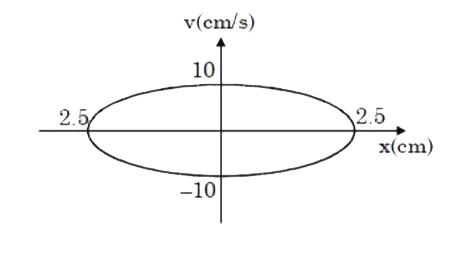Explain displacement, velocity, acceleration and time period in SHMs. Find the relation for them.
To explain displacement, velocity, acceleration, and time period in Simple Harmonic Motion (SHM) and find the relations between them, we can follow these steps:
1. Displacement in SHM:
- Displacement (y) in SHM is defined as the distance of the particle from its mean position at any instant. It can be expressed mathematically as:
y=Asin(ωt+ϕ)
where:
- A is the amplitude (maximum displacement),
- ω is the angular frequency,
- t is the time,
- ϕ is the phase constant.
2. Velocity in SHM:
- Velocity (v) is the rate of change of displacement with respect to time. It can be derived by differentiating the displacement function:
v=dydt=Aωcos(ωt+ϕ)
3. Acceleration in SHM:
- Acceleration (a) is the rate of change of velocity with respect to time. It can be obtained by differentiating the velocity function:
a=dvdt=−Aω2sin(ωt+ϕ)
- Alternatively, since y=Asin(ωt+ϕ), we can express acceleration in terms of displacement:
a=−ω2y
4. Time Period in SHM:
- The time period (T) is the time taken for one complete cycle of motion. It is related to the angular frequency (ω) by the formula:
T=2πω
5. Relations Between Displacement, Velocity, Acceleration, and Time Period:
- From the equations derived:
- Displacement: y=Asin(ωt+ϕ)
- Velocity: v=Aωcos(ωt+ϕ)
- Acceleration: a=−ω2y
- Time Period: T=2πω
- We can express the relationships:
- The velocity is the derivative of displacement with respect to time.
- The acceleration is the derivative of velocity with respect to time, or the second derivative of displacement with respect to time.
- The time period relates to the angular frequency, which in turn relates to the maximum values of displacement and velocity.
Summary of Relations:
- v=Aωcos(ωt+ϕ)
- a=−ω2y
- T=2πω
- Displacement (y) in SHM is defined as the distance of the particle from its mean position at any instant. It can be expressed mathematically as:
y=Asin(ωt+ϕ)
where:
- A is the amplitude (maximum displacement),
- ω is the angular frequency,
- t is the time,
- ϕ is the phase constant.
- Velocity (v) is the rate of change of displacement with respect to time. It can be derived by differentiating the displacement function:
v=dydt=Aωcos(ωt+ϕ)
- Acceleration (a) is the rate of change of velocity with respect to time. It can be obtained by differentiating the velocity function:
a=dvdt=−Aω2sin(ωt+ϕ)
- Alternatively, since y=Asin(ωt+ϕ), we can express acceleration in terms of displacement:
a=−ω2y
- The time period (T) is the time taken for one complete cycle of motion. It is related to the angular frequency (ω) by the formula:
T=2πω
- From the equations derived:
- Displacement: y=Asin(ωt+ϕ)
- Velocity: v=Aωcos(ωt+ϕ)
- Acceleration: a=−ω2y
- Time Period: T=2πω
- The velocity is the derivative of displacement with respect to time.
- The acceleration is the derivative of velocity with respect to time, or the second derivative of displacement with respect to time.
- The time period relates to the angular frequency, which in turn relates to the maximum values of displacement and velocity.
- v=Aωcos(ωt+ϕ)
- a=−ω2y
- T=2πω
Topper's Solved these Questions
- BOOK - PRADEEPCHAPTER - OSCILLATIONS AND WAVESEXERCISE - Advanced Problems For Competitions20videos
OSCILLATIONS AND WAVES
- BOOK - PRADEEPCHAPTER - OSCILLATIONS AND WAVESEXERCISE - NCERT EXERCISES WITH SOLUTIONS19videos
OSCILLATIONS AND WAVES
- BOOK - PRADEEPCHAPTER - OSCILLATIONS AND WAVESEXERCISE - Short Answer Questions104videos
OSCILLATIONS AND WAVES
- BOOK - PRADEEPCHAPTER - MATHEMATICAL TOOLSEXERCISE - Fill in the blanks5videos
MATHEMATICAL TOOLS
- BOOK - PRADEEPCHAPTER - PHYSICAL WORLD AND MEASUREMENTEXERCISE - Competiton Focus Jee Medical Entrance18videos
PHYSICAL WORLD AND MEASUREMENT
Similar Questions
Knowledge Check
- Question 1 - Select One
The displacement of a particle in an SHM in one time period is
AAB2AC4ADzero - Question 2 - Select One
If x,v and a denote the displacement, the velocity and the acceleration of a particle executing simple harmonic motion of time period T, then, which of the following does not change with time ?
AaTxBaT+2πvCaTvDa2T2+4π2v2 - Question 3 - Select One or More
If y, v and a represent displacement velocity and acceleration at any instant for a particle executing SHM, which of the following statements are true?
Av and y may have same direction.Bv and a may have same direction.Ca and y may have same direction.Da and v may have opposite direction.
Represent graphically the displacement, velocity and acceleration against time for a particle performing linear SHM starting from the positive extreme position. State the conclusions.
View SolutionA particle executed SHM iwht a time period of 3s and amplitude 6cm. Find (i) displacement (ii) velocity and (iii) acceleration, after 1/2 second, starting from the mean position.
View SolutionA graph between velocity and displacement of a particle performing SHM is shown. Find the acceleration when the particle is at half of maximum displacement from mean position.
 View Solution
View SolutionTIME PERIOD OR PERIOD OF OSCILLATION
View SolutionWhich of the following diagrams correctly relate displacement velocity and acceleration with time for a particle executing SHM
View Solution

